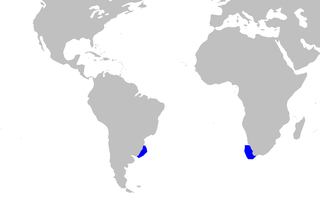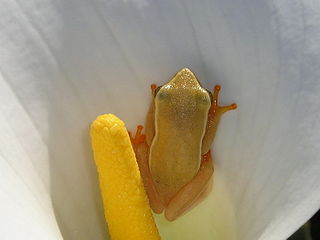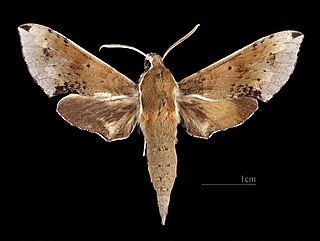
In botany, a spadix is a type of inflorescence having small flowers borne on a fleshy stem. Spadices are typical of the family Araceae, the arums or aroids. The spadix is typically surrounded by a leaf-like curved bract known as a spathe. For example, the "flower" of the well known Anthurium spp. is a typical spadix with a large colorful spathe.

Zantedeschia is a genus of eight species of herbaceous, perennial, flowering plants in the aroid family, Araceae, native to southern Africa. The genus has been introduced, in some form, on every continent.

Zantedeschia aethiopica, commonly known as calla lily and arum lily, is a species of flowering plant in the family Araceae, native to southern Africa in Lesotho, South Africa, and Eswatini.
Easter lily may refer to:
Calla lily is a common name of several members of the family, Araceae. It may refer to:
Green Goddess refers to the Bedford RLHZ Self Propelled Pump, a fire engine used by the British Armed Forces.

The taillight shark is a little-known species of shark in the family Dalatiidae and the only member of its genus. It is known from only four specimens collected from deep oceanic waters in the southern Atlantic Ocean and Pacific Ocean. A small shark with a laterally compressed body and a bulbous snout, this species has unusual adaptations that indicate a specialized lifestyle: its pectoral fins are paddle-like and may be used for propulsion, unlike other sharks and it has a pouch-like gland on its abdomen that emits clouds of luminescent blue fluid. This shark is likely aplacental viviparous and a formidable predator for its size.
Lily of the Nile is a common name for several plants and may refer to:

The arum lily reed frog, Horstock's arum-frog, arum lily frog, or Horstock's reed frog is a species of frog in the family Hyperoliidae. It is endemic to South Africa.
Novosphingobium is a genus of Gram-negative bacteria that includes N. taihuense, which can degrade aromatic compounds such as phenol, aniline, nitrobenzene and phenanthrene. The species N. aromativorans, which was first found in Ulsan Bay, similarly degrades aromatic molecules of two to five rings.
Sugarloaf Rock is a small granite island, with an area of 1.07 ha, in south-eastern Australia. It is part of Tasmania’s Curtis Group, lying in northern Bass Strait between the Furneaux Group and Wilsons Promontory in Victoria.
R. africana may refer to:

Theretra monteironis is a moth of the family Sphingidae. It is known from dry habitats from KwaZulu-Natal to eastern Kenya.

Theretra tryoni is a moth of the family Sphingidae. It is known from Papua New Guinea, Queensland and north-eastern New South Wales.

Rhagastis mongoliana is a moth of the family Sphingidae.
Delftia litopenaei is a Gram-negative, short-rod-shaped, non-spore-forming, motile bacterium from the Comamonadaceae family, which was isolated from a freshwater shrimp culture pond in Taiwan. It has the ability to accumulate poly-β-hydroxybutyrate.
Paraburkholderia nodosa is a gram-negative, catalase and oxidase-positive, non-spore-forming, bacterium from the genus Paraburkholderia and the family Burkholderiaceae which was isolated from nitrogen-fixing nodules from roots of Mimosa bimucronata and Mimosa scabrella.
Cellvibrio diazotrophicus is a Gram-negative, rod-shaped, aerobic and nitrogen-fixing bacterium from the genus of Cellvibrio which has been isolated from the rhizosphere of the plants Plantago winteri and Hordeum secalinum near Münzenberg in Germany.
Cellvibrio fibrivorans is a bacterium from the genus of Cellvibrio which has been isolated from soil from a Botanic garden in Ghent in Belgium.






